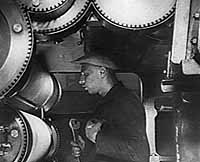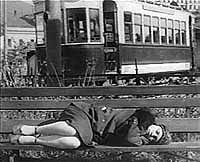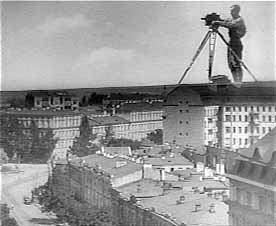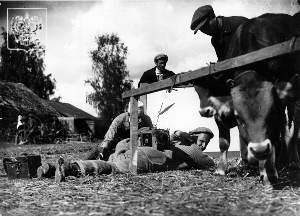| Contributions to the Cinematic Image | Keywords | |
 |
Lengths Feet and Longer Loops Thomas Edison Laboratories - Dickson and Brown (USA) |
|
|
1889 Kinetoscope
|
Kinetoscope
1888 Thomas Edison meets Eadweard Muybridge, who shows him his zoopraxiscope; Edison sets William K. L. Dickson and other assistants to work to make a kinetoscope, "an instrument which does for the Eye what the phonograph does for the Ear". Edison’s assistant, William Dickson solved the mechanical problem of moving celluloid film through a camera, developing the sprocket system still in use. Edison files his first caveat (a Patent Office document in which one declares his work on a particular invention in anticipation of filing a patent application) on the Kinetoscope and Kinetograph on October 8. Link The invention of the Kinetoscope influenced all subsequent motion
picture devices. The Kinetoscope was completed by 1892..
The Kinetoscope contains a loop of about 46 feet (14 metres) of film which ran at 46 frames a second, giving the viewer just twenty seconds of moving pictures. Later machines were enlarged to contain 150 feet (45 metres) of film running at 30 frames a second, giving 80 seconds viewing time. This allowed a round of the popular boxing films to fit on a single machine. Vitascope Kinetophone
1889 George Eastman began the manufacture of photographic
film strips using a nitro-cellulose base
Screenings Sound for film required the technical capability to synchronize the audio elements with those of the picture. Technology was needed that could both record and reproduce audio clearly in large halls. In 1926 Warner Brothers premiered their audio Vitaphone system. The Vitaphone used a phonograph disc, loudspeakers and electronic amplification. 1927's "The Jazz Singer", a silent picture with a Vitaphone score, is considered the world's first talking picture. The early years of cinema saw huge changes and evolutions in form, technology and exhibition. This period saw films grow from 60-second observational exercises into feature entertainment. The sideshow at the county fair soon became the primary leisure activity. The back rooms of cafes became 1000 seat movie palaces. Viewing and Screening Link to Photo FilmStrips |
One camera records succesive images
|
|
|
||
|
THE EVENT - NOVELTY OF MOVEMENT
|
||
 |
Vaudeville Acts Video Clip Link - Eugene Sandow
Edison Company's actuality films The Edison Company's actuality films contained scenes of
vaudeville performers, notable persons, railway trains, scenic
places, foreign views, fire and police workers, military exercises,
parades, naval scenes, expositions, parades, and sporting events. A
newly-invented mobile camera had made it possible for the Edison
Company to film everyday scenes in places outside the studio in a
fashion similar to the French Lumière films. Comic skits and films
relying on trick effects in the style of French filmmaker Georges
Méliès were also popular. LINKS TO EDISTON SITE WITH LOTS OF VIDEO CLIPS AND AUDIO
SAMPLES History of Edison Motion Pictures Fiction Films - Acted films became more popular than actuality Films. |
|
|
TYPES OF FILMS CREATED Actualities, Advertising, Animation, Early Documentary-Style Films, Drama and Adventure, Humorous, Trick, Reenactments |
||
|
FILMS |
||
|
The Life of an American Fireman |
FICTION - STAGED CONTENT 1903 Edwin S. Porter, working for Edison makes "The Life of an American Fireman" which displayed new visual storytelling techniques and incorporated stock footage with Porter's own photography. It acted as a major precursor to Porter's most famous film "The Great Train Robbery" also made in 1903 which displayed effective use of editing and photography technique.
Video Link - Download Video Clips - High RES Real Media Version available
at: |
Use of Editing and Photography Technique |
|
|
LINKS http://www.precinemahistory.net/1890.htm
|
|
 Lumière brothers photo and clips of "Le Repas ou Repas de bébé" and "Barque sortant du port" |
Lumiére Brothers - Cinématographe | |
|
One of the first commercial, public showings of a motion picture (and made with a celluloid film camera/projector), took place December 28 of 1895 at the Grand Café on the boulevard des Capucines in Paris. The Lumiere’s used the basement to open their movie theatre known as the ‘Cinematographe Lumiere Freres' . A private showing of the machine took place in March of the same year. The device was the Cinematographe (below left & right), and was used in scheduled showings from that point on. It was constructed by Jules Carpentier of the Lumiere factory, and had a claw-like mechanism in order to provide the required intermittent pull-down movement of 35mm perforated-celluloid film. The film which had two perforations per frame, was also manufacured by the Lumiere business. |
||
|
The Lumière's (France) 1895 Louis and Augustine Lumiere issued a patent for a device called a cinematograph capable of projecting moving pictures |
Cinématographe
|
Portable Record, View and Project in One Device
|
|
FILMS | ||
| CAMERAS BASIC FUNCTIONS | ||
|
The Arrival of a Train at Grand Central Station (1895) Workers Leaving the Lumiére Factory and Arrival of a Train in the Station. |
The Lumieres represent a mode of filmmaking which attempts to let the film camera's basic function--the mechanical reproduction of visual reality--remain at the center of the film's interest. This approach to filmmaking would eventually spawn the documentary, and was typically defended by a group of film theorists known as the Realists.
1895 The first experimentation by Louis Lumière of the Cinematographe camera showed everyday real events. His film The Arrival of a Train at Grand Central Station (1895) showed the train coming in diagonally across the screen, a very unconventional method of framing. Therefore, the Lumières pioneered not just the technical attributes of the camera but also its artistic attributes, creating a dialogue of realism that has always been a crux of cinema. |
Movement through the frame provides the primary means of visual
pleasure. Link
|
|
|
THRILLING ENTERTAINMENT - MANIPULATING REALITY IN FRONT OF THE CAMERA
|
|
|
Voyage to the moon
|
Georges Melies represents a mode of filmmaking which attempts to use the plastic, malleable features of the cinema (editing, trick photography, special effects) to produce a manipulation of the reality that was present in front of the camera as the film was recorded. 1902 Georges Méliès produces his magnificent "Voyage to the Moon", a fifteen minute epic fantasy parodying the writings of Jules Verne and HG Wells. The film used innovative special effect techniques and introduced colour to the screen through hand-painting and tinting.
LINK TO REAL MEDIA CLIP http://www.mshepley.btinternet.co.uk/head.rm
|
Méliès work provides an early example of film technique that uses spectacle and special effects to produce visual pleasure. Link Special Effects Uses technique of multiple exposure Effects Camera Techniques |
| Mary Janes Mishap | 1903 British film maker George Smith makes Mary Janes Mishap which was praised for its sophisticated use of editing. The film uses medium close-ups to draw the viewers attention to the scene, juxtaposed with wide establishing shots. The film also contains a pair of wipes which signal a scene change. | Use of Editing |
|
FORMALIST
|
||
| DW GRIFFIN Birth of a Nation "FATHER of NARRATIVE" |
One of the most important figures of the early years was D.W. Griffith. Griffith is heralded as having established modern film narrative. His first feature is, unfortunately, one of the most contentious films in American Cinema, "Birth of a Nation" (1915). The film is a notorious depiction of an ante-bellum American South. The story decries the former slave population of America as shiftless and immoral and glorifies the establishment of the Ku Klux Klan. When the film was released, there was a huge outcry regarding the blatantly racist content and the portrayal of blacks in the American South. From a contemporary perspective, it is still offensive. "Birth of a Nation" is the quintessential example of film structure. Griffith's development of plot, and his dramatic use of editing and parallel storytelling became integral to the structure of Hollywood and mainstream filmmaking. Using double exposures and cross-referencing images, story elements and characters, Griffith was able to establish a complex, visual narrative. | |
|
IMPRESSIONIST - FRENCH AVANT GARDE Photographing an object, wrote Delluc, lends it new meaning by opening the viewer to the perspective of the person filming. |
||
|
NAPOLEAN 1927
TRAILER TO NAPOLEAN 1927 Link |
The Impressionists at first concentrated on the image, using optical tricks to illustrate the impressions of the characters: dreams, memories, visions and thoughts. They made shots with a distorted mirror, put excerpts of pictures through filters, or divided the frame into smaller individual pictures. They emphasised subjectivity with the "subjective camera"; using extreme perspectives, and tilted angles and movements that showed the scene through the eyes of the characters. They attached great importance to the mise-en-scene (the staging). They encouraged untheatrical and reserved acting, and used lighting effectively to illuminate sets that were often designed by contemporary painters and architects in the cubist or art deco style. After 1923 the Impressionists moved away from the picture and camera focus to experiment with quick rhythmical cut sequences, having been inspired, like many, by Griffith's daring montages. Rendering the world through emotions and impressions. Abel Gance, hated static scenes. "Napoleon" is full of shots where the camera moves on pendulums and gyroscopes.
Albert Dieudonne as Napoleon in the spectacular 3 screen Polyvision finale of Napoleon. Polyvision predated Cinerma by 25 or so years. Link
Another example of Polyvision
ART AND CULTURE LINK
|
|
|
Metropolis (1926, Fantascienza - con Alfred Abel, Fritz Alberti, e Grete Berger) |
REAL MEDIA VERSION STREAMED AT: http://xoom.virgilio.it/classicmovies/fantascienza.php Other links
The most direct contribution was made by the special effects photographer Schufftan, who invented a process which still bears his name today: "miniatures are reflected onto a glass with a magnifying mirrored surface, which is placed at a 45 angle relative to the camera lens. This surface is scraped away from the areas in which live action is to take place, leaving holes behind which the actual sets are constructed and lit to correspond with the lighting of the model." Link |
|
|
EARLY SOVIET CINEMA - FORMALISTS - CINEMA AND ART AS TOOLS FOR SOCIAL CHANGE
|
||
|
At the film college in Moscow a group of young filmmakers gathered under the leadership of Lev Kuleshov, who attempted to find theoretical and experimental ways in which abstract thoughts could be portrayed on film. The primary thesis was that in the cinema the cut ranks ahead of the picture content, so meaning is communicated through montage rather than mise-en-scene. "With montage", stated Kuleshov, " one can destroy, repair, or entirely reformulate one's material". Among the most important representatives of the movement are Sergei Eisenstein, Vsevolod Pudovkin, and Dziga Vertov. They showed in their films the multiple possibilities of cinematic montage. Eisenstein first promoted the "montage of attractions" and the "collision montage", a quick sequence of emotionally charged pictures, which in a shocking manner collide with one another in order to shake the viewer and to bring him to new realisations. In his first film "Strike", he combined images of the murder of strikers against bloody sequences from a slaughterhouse. Montage served Pudovkin as a means to illustrate feelings and had the goal of awakening the emotions of the viewers rather than provoking them to be reflective. The images of protesting factory workers alternates with rays of sunlight, which tear through the walls of clouds, forming a metaphor of revolutionary hope. Stalinist totalitarianism finally put a halt to the desire for experimentation of the Soviet avant-garde, and from then on, Soviet films were supposed to offer either light entertainment or encourage the formation of the socialist state. Lev Kuleshov and Dziga Vertov - pioneers of Soviet cinema, working under economic constraints, re-edited existing film-stock to develop their ideas of film grammar. Kuleshov experimented with how shots before and after an image affected its interpretation. He realized he could modify an audience's reaction to a shot by changed the images either side of it in a montage sequence. Vertov developed an influential theory called Kino-Pravda (film truth) and stressed the importance of rhythm in editing, for example, speeding up a montage sequence towards its climax. Link |
||
| Dziga Vertov The Man with the Movie Camera |
Dziga Vertov
Show the masses fantastic images of the good life, Vertov maintained, and they will lie about complacently, dreaming of a day when they too can luxuriate in baths of plenty. Vertov loathed these so-called fiction films and insisted that the future of cinema depended on reporting the truth.... "Man with a Movie Camera" (1929) stunned audiences with its highly self-conscious use of the camera as the eye to replace the human eye. A day-in-the-life of an urban metropolis like Moscow, "Man with a Movie Camera" employed the montage techniques that Vertov mastered back in medical school. ... Often deemed the "Father of Cinema Verité," Vertov's liberal editing style and highly sophisticated camera techniques ensured his venerable spot on cinema's timeline. ... http://www.artandculture.com/cgi-bin/WebObjects/ACLive.woa/wa/artist?id=1284 Dziga Vertov's Man With a Movie Camera (1929) is a stunning avant-garde, documentary meta-narrative which celebrates Soviet workers and filmmaking. The film uses radical editing techniques and cinematic pyrotechnics to portray a typical day in Moscow from dawn to dusk. But Vertov isn't just recording reality, he transforms it through the power of the camera's "kino-glaz" (cinema eye). Vertov desired to create cinema that had its own "rhythm, one lifted from nowhere else, and we find it in the movements of things." For Vertov an emphasis on the psychological interfered with the worker's "desire for kinship with the machine." And as a peoples' artist, Vertov felt that the peoples' cinema must "introduce creative joy into all mechanical labor" and "foster new people." As Vertov revealed the joys of work, the rhythm of workers and machines, he also felt that filmmaking (as a largely technological medium) was also a component of that mechanical reality.
http://www.imagesjournal.com/issue05/reviews/vertov.htm
|
|
|
The Battleship Potemkin
In 1925, in order to commemorate the Revolution of 1905, the Communist Party commissioned the renowned film "Potemkin" (also called " battleship Potemkin"). The film was made in the Black Sea port of Odessa. In 1958 it was voted the best film ever made, by an international poll of critics.
|
Sergei Eisenstein Eisenstein constructed these films using shots as his cinematic building blocks. He avoided long takes, which detracted from the control he could exert over his images and the impact they subsequently had on an audience. The short shots were referred to as shocks or attractions because they stood out and commanded attention within a film. These shocks were edited together in a process called montage, to convey a particular meaning. For example, in Strike the nature of the slaughter perpetrated by the Cossack army is conveyed by juxtaposing scenes of advancing soldiers with a bull being slaughtered and ink being spilt over a street-map of the city being attacked. REAL MEDIA VERSION STREAMED AT: http://xoom.virgilio.it/classicmovies/drammatico.php
Following from http://www.abamedia.com/rao/gallery/old/eisen.html EisensteinÕs first film, the revolutionary "Strike," was produced in 1924, following the publishing of his first article on theories of editing in the review Lef, edited by the great poet, Mayakovsky. He proposed a new editing form, the "montage of attractions" -- in which arbitrarily chosen images, independent from the action, would be presented not in chronological sequence but in whatever way would create the maximum psychological impact. Thus, the filmmaker should aim to establish in the consciousness of the spectators the elements that would lead them to the idea he wants to communicate. He should attempt to place them in the spiritual state or the psychological situation that would give birth to that idea. He theorized that cinema was a synthesis of art and science. These principles guided Eisenstein's entire career, and had a major impact on filmmakers to this day for its stark contrast to "American-style" narrative montage. Following from http://faculty.dwc.edu/wellman/film.htm Battleship Potemkin (1925) in the sequence shot on the Odessa Steps, provides the classic example of film montage. Rapid cuts, shot and counter-shot, sustaining the narrative action and adding a dimension of emotional excitation that is itself a source of visual pleasure. Eisenstein's film is a fictionalized recreation of episodes from the 1905 Revolution in Russia. In the tradition of D.W. Griffith's epics like The Birth of a Nation (1915) and Intolerance (1916). Extending the power of the history film through his use of montage, Eisenstein's Battleship Potemkin, inscribes a moment crucial to the founding ideology of Russia during the first years of Stalin's dictatorship. Sergei Eisenstein's Battleship Potemkin (1925) in the sequence
shot on the Odessa Steps, provides the classic example of film
montage. Rapid cuts, shot and counter-shot, sustaining the narrative
action and adding a dimension of emotional excitation that is itself
a source of visual pleasure. Eisenstein's film is a fictionalized
recreation of episodes from the 1905 Revolution in Russia. In the
tradition of D.W. Griffith's epics like The Birth of a Nation (1915)
and Intolerance (1916). Griffith's films established the genre of
the historical drama and like most such films inscribes contemporary
ideologies (including in Griffith's case an embrace of the Ku Klux
Klan in The Birth of a Nation). Extending the power of the history
film through his use of montage, Eisenstein's Battleship Potemkin,
inscribes a moment crucial to the founding ideology of Russia during
the first years of Stalin's dictatorship. |
Montage of Attractions
The riveting effects of montage, produced in the cutting room and the seemingly authentic recreation of history in Battleship Potemkin return us our initial set of analytical parameters, those between documentary footage shot in the camera and those constructed effects that derive from editing and film plastics. Seeming authenticity is not disturbed and is often enhanced by shot/counter-shot editing. Visual pleasure we will see even normalizes itself to the hybrid effects of the jump cuts used by Jean-Luc Godard in Breathless (1959). From |
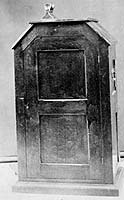

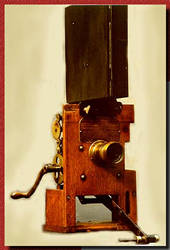


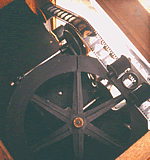





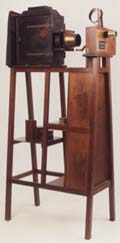 Based on
the Kinetoscope, The Cinématographe, invented by Auguste and Louis
Lumière was a combined camera, projector and printer. Here it is set
up for projection, using a magic lantern lamphouse as a light
source. The Cinématographe was hand-cranked and the film ran from
the top spool holder though the projector to a box in the stand
below.
Based on
the Kinetoscope, The Cinématographe, invented by Auguste and Louis
Lumière was a combined camera, projector and printer. Here it is set
up for projection, using a magic lantern lamphouse as a light
source. The Cinématographe was hand-cranked and the film ran from
the top spool holder though the projector to a box in the stand
below. 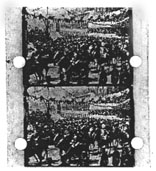

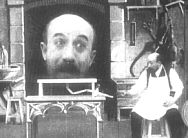 1902 served up two of his most distinguished and
delightful pieces, the celebrated L'Homme a la Tete de
Coaoutchouc (The Man With the Rubber Head) in which Méliès' head
is seen to expand to bursting point after his half-witted assistant
energetically pumps a pair of giant bellows. This devious, but
simple illusion was executed by constructing a small carriage on a
track that was moved slowly towards the static camera, thus
enlarging the head. Today film-makers employ a track to move the
camera in what is termed a "dolly
shot".
1902 served up two of his most distinguished and
delightful pieces, the celebrated L'Homme a la Tete de
Coaoutchouc (The Man With the Rubber Head) in which Méliès' head
is seen to expand to bursting point after his half-witted assistant
energetically pumps a pair of giant bellows. This devious, but
simple illusion was executed by constructing a small carriage on a
track that was moved slowly towards the static camera, thus
enlarging the head. Today film-makers employ a track to move the
camera in what is termed a "dolly
shot". 

